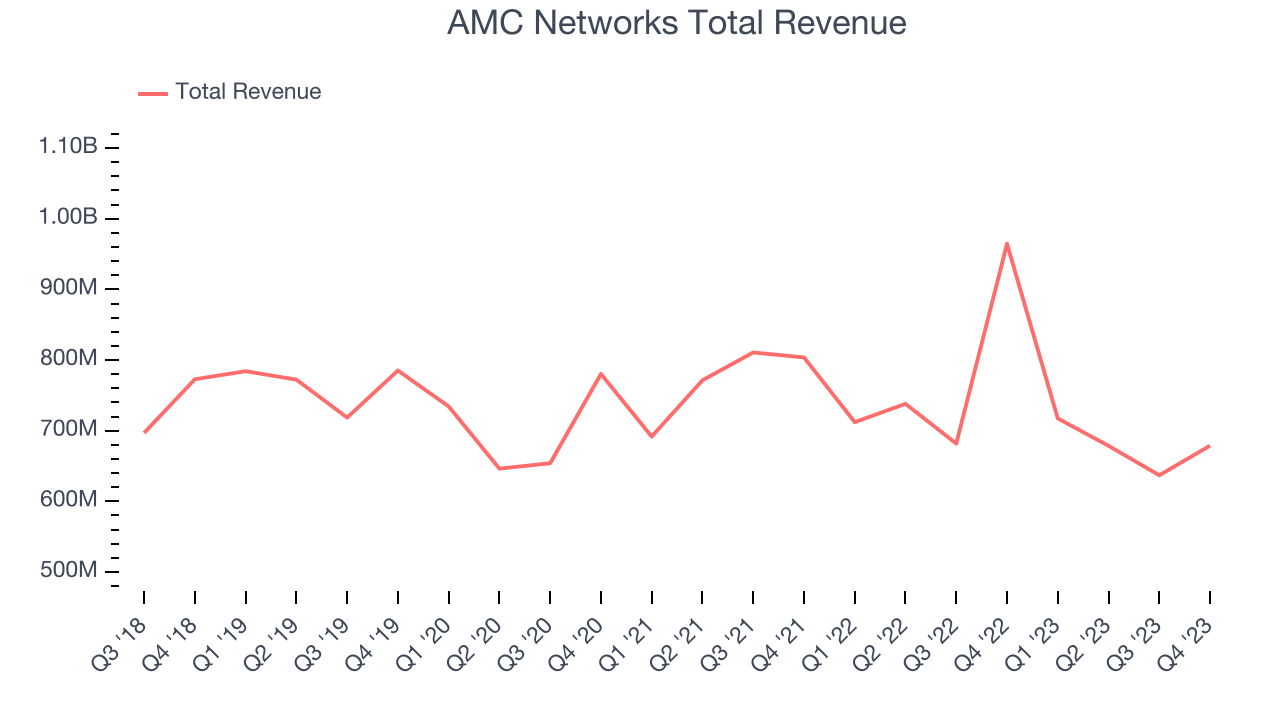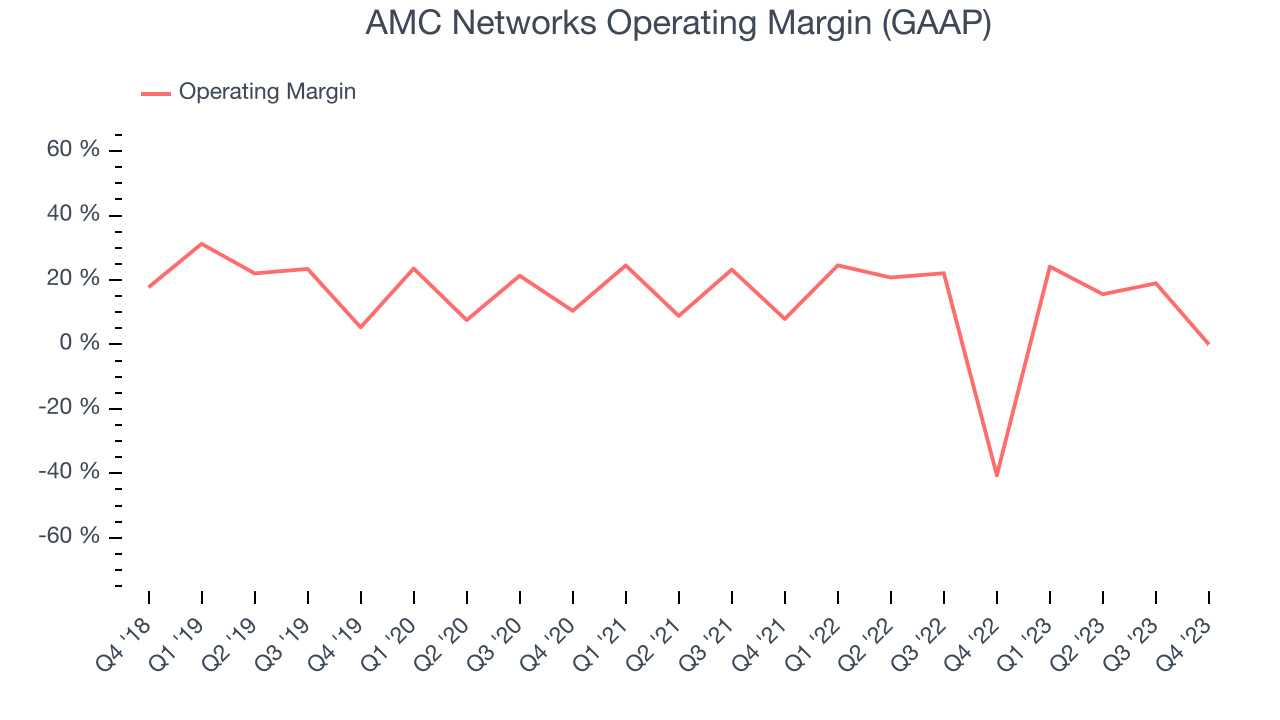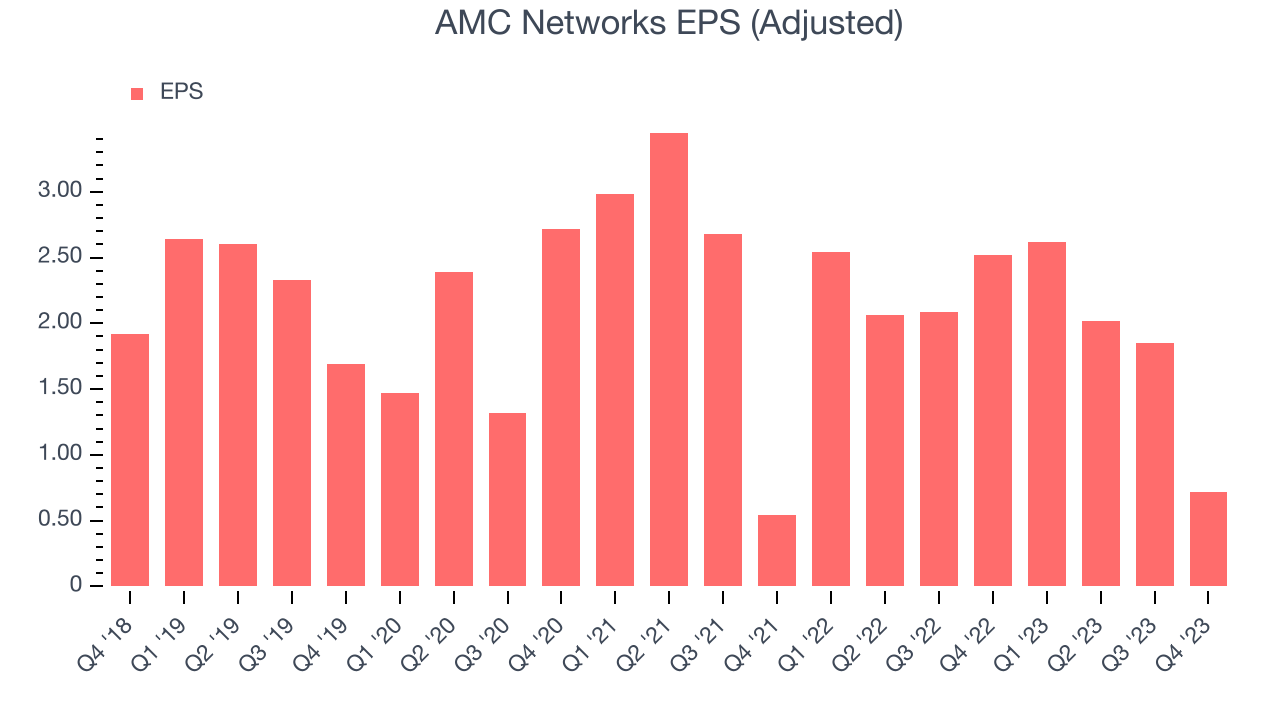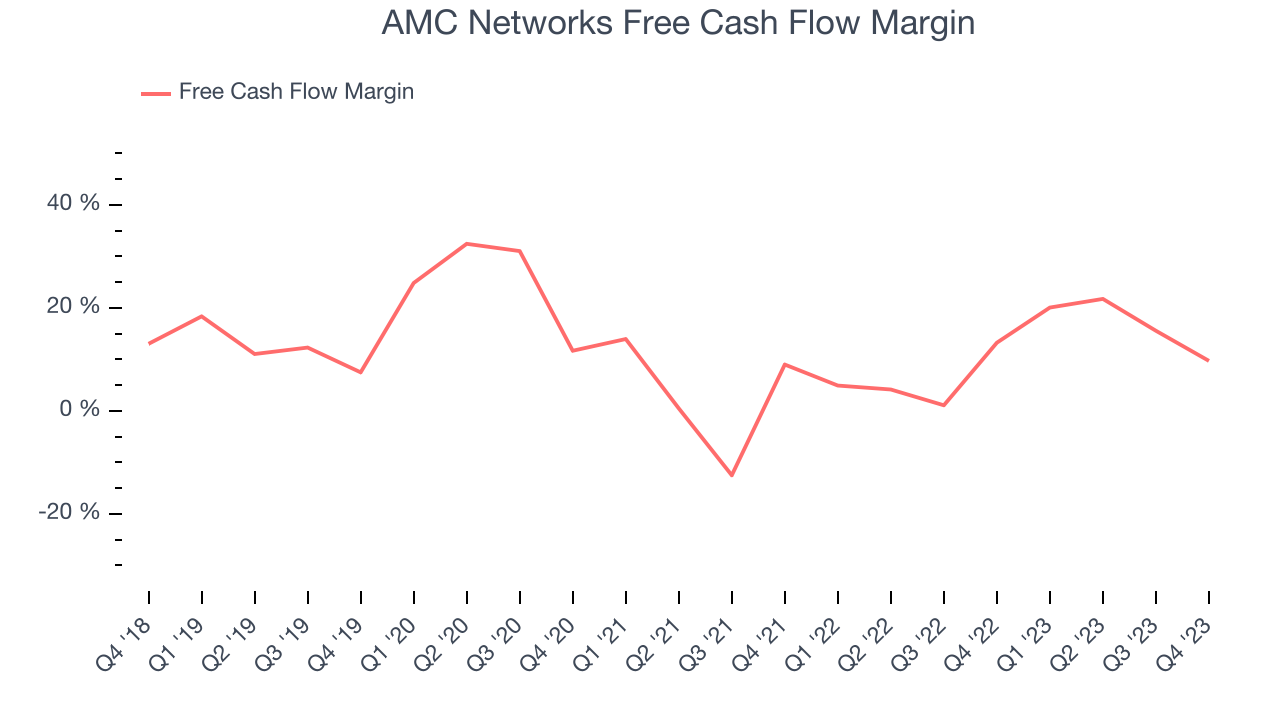Television broadcasting and production company AMC Networks (NASDAQ:AMCX) reported results in line with analysts' expectations in Q4 FY2023, with revenue down 29.6% year on year to $678.8 million. It made a non-GAAP profit of $0.72 per share, down from its profit of $2.52 per share in the same quarter last year.
AMC Networks (AMCX) Q4 FY2023 Highlights:
- Revenue: $678.8 million vs analyst estimates of $674.3 million (small beat)
- Adjusted operating profit: $100.3 million vs analyst estimates of $102.8 million (2.4% miss)
- EPS (non-GAAP): $0.72 vs analyst expectations of $0.84 (14.2% miss)
- Free Cash Flow of $65.97 million, down 33.5% from the previous quarter
- Gross Margin (GAAP): 42%, up from 36.5% in the same quarter last year
- Market Capitalization: $742.2 million
Originally the joint-venture of four cable television companies, AMC Networks (NASDAQ:AMCX) is a broadcaster producing a diverse range of television shows and movies.
AMC Networks was founded to create orginal, high-quality television and film content. The company's first channel was AMC, known for its classic movies, and it has since expanded to include BBC America, IFC, SundanceTV, and WE TV. These channels offer a variety of genres to audiences.
The company's portfolio features critically acclaimed original series, independent films, and documentaries, and it generates revenue through cable licensing fees, advertising sales, and digital streaming.
In response to the evolving media landscape, the company has effectively balanced traditional cable broadcasting with online streaming. This dual-channel strategy expands its reach as it appeals to both traditional cable subscribers and an increasingly online audience.
Broadcasting
Broadcasting companies have been facing secular headwinds in the form of consumers abandoning traditional television and radio in favor of streaming services. As a result, many broadcasting companies have evolved by forming distribution agreements with major streaming platforms so they can get in on part of the action, but will these subscription revenues be as high quality and high margin as their legacy revenues? Only time will tell which of these broadcasters will survive the sea changes of technological advancement and fragmenting consumer attention.
Competitors in the television and media production industry include Lions Gate Entertainment (NYSE:LGF.A), Paramount Global (NASDAQ:PARA), and Warner Bros. Discovery (NASDAQ:WBD).Sales Growth
Examining a company's long-term performance can provide clues about its business quality. Any business can put up a good quarter or two, but the best consistently grow over the long haul. AMC Networks's revenue declined over the last 5 years, dropping 1.8% annually.

Within consumer discretionary, product cycles are short and revenue can be hit-driven due to rapidly changing trends. That's why we also follow short-term performance. AMC Networks's recent history shows its demand has decreased even further, as its revenue has shown annualized declines of 6.1% over the last 2 years.
This quarter, AMC Networks reported a rather uninspiring 29.6% year-on-year revenue decline to $678.8 million of revenue, in line with Wall Street's estimates. Looking ahead, Wall Street expects revenue to decline 1.1% over the next 12 months.
Operating Margin
Operating margin is an important measure of profitability. It’s the portion of revenue left after accounting for all core expenses–everything from the cost of goods sold to advertising and wages. Operating margin is also useful for comparing profitability across companies with different levels of debt and tax rates because it excludes interest and taxes.
AMC Networks has done a decent job managing its expenses over the last eight quarters. The company has produced an average operating margin of 10.7%, higher than the broader consumer discretionary sector.
In Q4, AMC Networks generated an operating profit margin of negative 0%, up 40.6 percentage points year on year. This increase indicates the company was more efficient with its expenses over the last quarter, spending less money in areas like corporate overhead and advertising.
Over the next 12 months, Wall Street expects AMC Networks to become more profitable. Analysts are expecting the company’s LTM operating margin of 14.7% to rise to 20.8%.EPS
We track long-term historical earnings per share (EPS) growth for the same reason as long-term revenue growth. Compared to revenue, however, EPS highlights whether a company's growth was profitable. 
Over the last 5 years, AMC Networks's EPS dropped 16.6%, translating into 3.6% annualized declines. We tend to steer our readers away from companies with falling EPS, especially in the consumer discretionary sector, where diminishing earnings could imply changing secular trends or consumer preferences. If there's no earnings growth, it's difficult to build confidence in a business's underlying fundamentals, leaving a low margin of safety around the company's valuation (making the stock susceptible to large downward swings).
In Q4, AMC Networks reported EPS at $0.72, down from $2.52 in the same quarter a year ago. This print unfortunately missed analysts' estimates, but we care more about long-term EPS growth rather than short-term movements. Over the next 12 months, Wall Street expects AMC Networks to grow its earnings. Analysts are projecting its LTM EPS of $7.21 to climb by 2.7% to $7.40.
Cash Is King
Although earnings are undoubtedly valuable for assessing company performance, we believe cash is king because you can't use accounting profits to pay the bills.
Over the last two years, AMC Networks has shown decent cash profitability, giving it some reinvestment opportunities. The company's free cash flow margin has averaged 11.3%, slightly better than the broader consumer discretionary sector.

AMC Networks's free cash flow came in at $65.97 million in Q4, equivalent to a 9.7% margin, down 48.4% year on year. Over the next year, analysts predict AMC Networks's cash profitability will fall. Their consensus estimates imply its LTM free cash flow margin of 16.8% will decrease to 8%.
Return on Invested Capital (ROIC)
EPS and free cash flow tell us whether a company was profitable while growing revenue. But was it capital-efficient? Enter ROIC, a metric showing how much operating profit a company generates relative to how much money the business raised (debt and equity).
AMC Networks's five-year average return on invested capital was 12.3%, somewhat low compared to the best consumer discretionary companies that pump out 25%+. Its returns suggest it historically did a subpar job investing in profitable business initiatives.
The trend in its ROIC, however, is often what surprises the market and drives the stock price. Unfortunately, over the last two years, AMC Networks's ROIC has averaged a 7.3 percentage point decrease each year. In conjunction with its already low returns, these declines suggest the company's profitable business opportunities are few and far between.
Key Takeaways from AMC Networks's Q4 Results
Revenue beat by a small amount, but both operating income and EPS missed. A bright spot was that free cash flow came in better than expected. From a product perspective, the company pointed out that AMC+ (the streaming platform) launched "an ad-supported tier in the third quarter, with strong new sign-up activity on available platforms since launch." Overall, this was a mixed quarter for AMC Networks. The stock is up 2.8% after reporting and currently trades at $17.5 per share.
Is Now The Time?
AMC Networks may have had a tough quarter, but investors should also consider its valuation and business qualities when assessing the investment opportunity.
We cheer for all companies serving consumers, but in the case of AMC Networks, we'll be cheering from the sidelines. Its revenue has declined over the last five years, but at least growth is expected to increase in the short term. On top of that, its declining ROIC shows its profitable business opportunities are shrinking, and its declining EPS over the last five years makes it hard to trust.
AMC Networks's price-to-earnings ratio based on the next 12 months is 2.3x. While we've no doubt one can find things to like about AMC Networks, we think there are better opportunities elsewhere in the market. We don't see many reasons to get involved at the moment.
Wall Street analysts covering the company had a one-year price target of $15.67 per share right before these results (compared to the current share price of $17.50), implying they didn't see much short-term potential in AMC Networks.
To get the best start with StockStory, check out our most recent stock picks, and then sign up for our earnings alerts by adding companies to your watchlist here. We typically have the quarterly earnings results analyzed within seconds of the data being released, and especially for companies reporting pre-market, this often gives investors the chance to react to the results before the market has fully absorbed the information.
